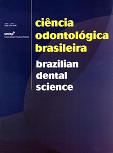Evaluation of the marginal fit of electroformed copings in function of the cervival preparation
DOI:
https://doi.org/10.14295/bds.2004.v7i1.406Abstract
The scope of this study was to evaluate the marginal fitness of coping made with the electroforming Gramm system. Two identical stainless steel master casts were milled simulating the tooth reduction for metal ceramic crowns; one with long chanfer and another with round shoulder preparations. The impression material used was a polivinilsyloxane silicone with the double impression technique, thus obtaining ten specimens of each máster cast. To establish a pattern for impression a sheet of accetate with 1,4 mm thick was used. A dental surveyor was prepared to maintain constant the insertion and the removal axis of the master casts during all the impressions. The dies were made with gypsum type IV and after the casts were dyed with spacer, these were duplicated with laboratory silicone to obtain a second master cast with special gypsum. The casts were prepare with copper wire and coated with silver to promove the galvanic current so that a gold eletroforming is achieved. Upon adjustment and cleansing, the copings were adjusted to the master casts, which were fixed in an octagonal stainless steel table, and observed at a measuring microscope Olympus equipped with digital desk. The data obtained was submitted to “t” test and Mann-Whitney statistical test with significance level of 5%. The mean values of long chanfer and round shoulder were 29,77mm and 26,77mm, respectively, (p=0,657 and p=1,00). With the results obtained, it may be concluded that there was not a statistically significant difference, so both marginal preparations may be used.
Downloads
Downloads
Published
How to Cite
Issue
Section
License
Brazilian Dental Science uses the Creative Commons (CC-BY 4.0) license, thus preserving the integrity of articles in an open access environment. The journal allows the author to retain publishing rights without restrictions.
=================




























